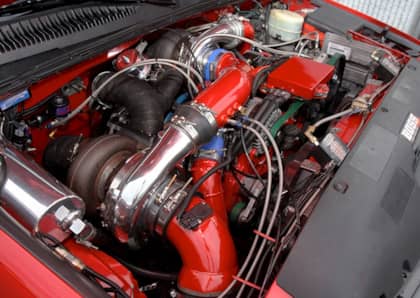Wastegates: The Simple Insurance Item Every Turbo Needs
Thanks to tremendous advancement in the world of forced induction, today’s turbochargers are tough pieces of hardware. Yet still, they have their limits. Push one too far and you can be rewarded with a fireworks display that’s not exactly the celebratory kind. A turbo that operates out of its compressor map, that sees excessive boost or drive pressure and that is being forced to turn breakneck shaft speeds can be avoided with the use of a relatively simple piece of technology: a wastegate. By controlling boost and drive pressure, a wastegate will keep your turbo safe—and it can even be used to fine-tune your engine’s horsepower.

Even if you’ve spec’d out a near-perfect, wastegate-free turbo arrangement—complete with a well-matched drive-to-boost pressure ratio—any future mods can throw off its carefully cultivated balance. As we all know, the pursuit of horsepower can be endless. Wastegates provide the kind of insurance policy that high-dollar turbos deserve. Below, we’ll spell out exactly what a wastegate accomplishes in its functionality, highlight the differences between internal and external versions and also showcase a few real-world examples. If you’re looking to spend big money on a turbo system or add nitrous to the equation, don’t build a boost bomb. Run a wastegate and sleep better at night knowing your turbo is safe(r).
Overspeed: The Biggest Justification For Wastegates

Other than ingestion from foreign debris (dust, dirt, a bolt left in the intake…), one of the biggest causes of turbo failure—especially in the performance realm—is overspeeding. Overspeeding occurs when a turbo is pushed beyond its engineering limits (compressor map, shaft speed, temperature threshold, etc.). A lot of bad things can happen when turbine shaft speed gets out of hand. Complete shaft failure, compressor wheel burst, the compressor wheel rubbing in the inducer bore (of the compressor housing) due to wheel growth, bearing failure and lack of proper lubrication can all be associated with overspeeding.
A Myriad Of Problems Arise From Excessive Drive Pressure

Oftentimes, drive pressure (the pressure present on the exhaust or drive side of the turbocharger) far exceeds the generally-accepted ideal drive-to-boost pressure ratio of 1:1. While a 1.5:1 drive-to-boost ratio is tolerable in most applications, anything higher than that and especially a 2:1 drive-to-boost ratio can get you into the danger zone quick. For example, when drive pressure is 90 psi and boost is 45 psi you have 45-psi worth of pressure working against the turbo’s thrust bearing. On top of that, a traditional journal bearing turbocharger is dependent on a thin layer of oil surrounding the shaft at all times. If a turbo sees too much drive pressure this cushion of oil can be squeezed out, causing metal-on-metal contact and imminent failure soon afterward.
What Exactly Is A Wastegate?

To keep boost, drive pressure and shaft speed in check, there is no better tool than a wastegate. A device that acts as a bypass valve to bleed off excess pressure, a wastegate can promote not just turbo longevity, but engine longevity as well. By relieving a turbo of excessive drive pressure, the turbine shaft’s rpm is limited, which drops the chances of experiencing an overspeed situation considerably. There are two types of wastegates: internal and external. Each type has its strengths and weaknesses, but either option is better than no wastegate at all.
Internal Wastegates

Thanks to being compact and highly packageable, you’ll typically find an internal wastegate employed in OEM applications such as the IHI RHG6 shown above (which came on the ’01-’04 LB7 Duramax 6.6L V-8 diesel). An internal wastegate is located within the turbocharger’s exhaust housing. Once a pre-determined boost pressure is met, the actuator forces open the bypass valve, which directs exhaust gases (i.e. drive pressure) around the turbine wheel rather than allowing it to pass through it. By routing drive pressure around the turbine wheel (the opening to the right of the turbine wheel), extreme drive pressure and shaft speeds are all but eliminated. As OEM equipment, internal wastegates are usually preset from the factory. They can be adjusted or even bypassed altogether in order to allow the turbo to produce more boost. However, this can push a turbo like the RHG6 to the brink before it produces 35 psi of boost, so do this at your own risk.
External Wastegates

You lose the compactness and tight-quarter packaging with an external wastegate, but you gain much more in the way of overall flow. This is why external wastegates are typically encountered in aftermarket and performance-intended turbo systems. Separate from the turbocharger, an external wastegate is typically mounted in the engine’s exhaust manifold (inline engines) or turbo up-pipes (V engines).

External wastegates can be vented to atmosphere, can be plumbed to feed into the turbo downpipe or—in compound turbo arrangements—mounted in the hot-pipe (what links the drive side of the two turbos together). The key components of an external wastegate are the main body, the diaphragm housing and the internal spring.
Fine-Tuning An External Wastegate

Varying actuator springs allow you to precisely dial-in exactly when an external wastegate will open. However, configuring an external wastegate to open at the ideal time is not exactly a walk in the park for the novice. Changing out springs can be laborious and time-consuming depending on where the external gate is mounted. For this reason it behooves you to mount the external wastegate in an easy-to-access location, whenever possible. While fine-tuning a wastegate in this fashion takes time, it’s the best way to precisely dial in your overall setup.

In contrast to configuring an external wastegate, setting up an internal wastegate is a bit simpler thanks in large part to a factory turbo being optimized right out of the box. Most internal wastegates can be adjusted without changing out springs. This is accomplished by turning the jam nuts on the wastegate actuator rod to either increase or decrease tension on the actuator spring.
In Drag Racing

Diesel drag racing is one form of motorsport that revolves around the use of turbos. Every engine has at least one and nitrous oxide is commonly added to the equation. In these scenarios the need for a wastegate becomes paramount for turbo longevity. A turbo that sees 60-psi of boost on fuel alone can easily jump to 75-psi of boost on the bottle, a 25-percent increase that could potentially push a non-wastegated turbo over the edge. Dialing in a wastegate for nitrous use (i.e. track use) is common to get the most out of a vehicle at the track without sacrificing turbo longevity or making life overly stressful for the engine.
In Sled Pulling

With a two-stage, triple-turbo configuration and a wild, Haisley Machine-built 6.7L-based Cummins that’s being fed enough fuel to power multiple engines, triple-digit boost and drive pressure is par for the course for a Super Stock diesel truck. In this particular case, in order to keep the high-dollar, ball-bearing Holset turbo on the exhaust manifold alive under extreme boost, the external wastegate up top directs excess drive pressure out one of the truck’s two hood stacks. This is a prime example of protecting your turbo and engine investment. An engine setup like this runs well north of $100,000 so it pays to make sure the turbo that sees the most abuse isn’t at risk of overspeeding. Further improving longevity, Super Stock engines such as this also make use of a separate oil system that’s dedicated exclusively to the turbochargers.
More From Driving Line
- Curious about the causes of turbo failure? Check out our in-depth look at the biggest turbo killers, along with how you can avoid them.











